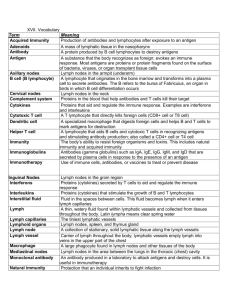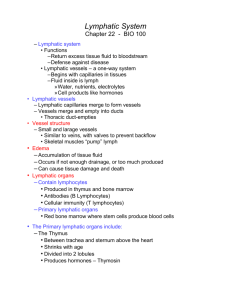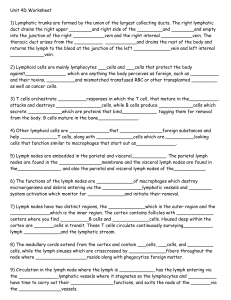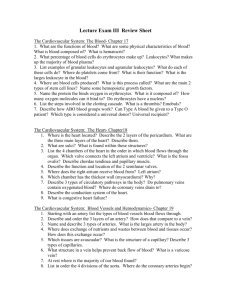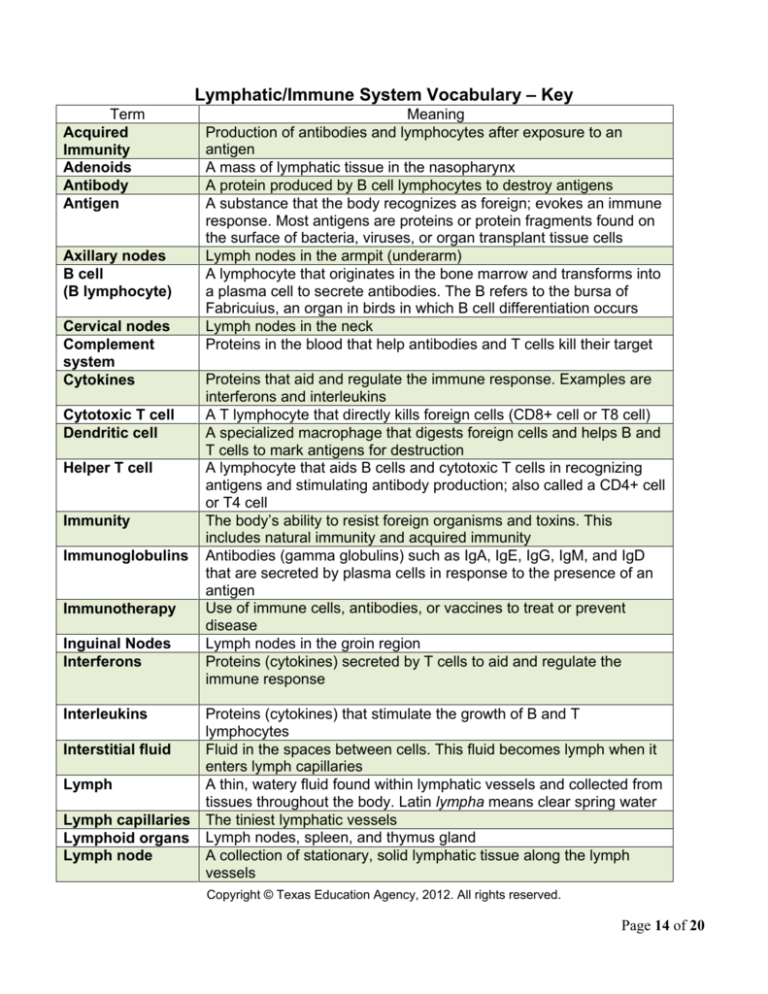
Lymphatic/Immune System Vocabulary – Key
Term
Acquired
Immunity
Adenoids
Antibody
Antigen
Axillary nodes
B cell
(B lymphocyte)
Cervical nodes
Complement
system
Cytokines
Cytotoxic T cell
Dendritic cell
Helper T cell
Immunity
Immunoglobulins
Immunotherapy
Inguinal Nodes
Interferons
Meaning
Production of antibodies and lymphocytes after exposure to an
antigen
A mass of lymphatic tissue in the nasopharynx
A protein produced by B cell lymphocytes to destroy antigens
A substance that the body recognizes as foreign; evokes an immune
response. Most antigens are proteins or protein fragments found on
the surface of bacteria, viruses, or organ transplant tissue cells
Lymph nodes in the armpit (underarm)
A lymphocyte that originates in the bone marrow and transforms into
a plasma cell to secrete antibodies. The B refers to the bursa of
Fabricuius, an organ in birds in which B cell differentiation occurs
Lymph nodes in the neck
Proteins in the blood that help antibodies and T cells kill their target
Proteins that aid and regulate the immune response. Examples are
interferons and interleukins
A T lymphocyte that directly kills foreign cells (CD8+ cell or T8 cell)
A specialized macrophage that digests foreign cells and helps B and
T cells to mark antigens for destruction
A lymphocyte that aids B cells and cytotoxic T cells in recognizing
antigens and stimulating antibody production; also called a CD4+ cell
or T4 cell
The body’s ability to resist foreign organisms and toxins. This
includes natural immunity and acquired immunity
Antibodies (gamma globulins) such as IgA, IgE, IgG, IgM, and IgD
that are secreted by plasma cells in response to the presence of an
antigen
Use of immune cells, antibodies, or vaccines to treat or prevent
disease
Lymph nodes in the groin region
Proteins (cytokines) secreted by T cells to aid and regulate the
immune response
Proteins (cytokines) that stimulate the growth of B and T
lymphocytes
Fluid in the spaces between cells. This fluid becomes lymph when it
Interstitial fluid
enters lymph capillaries
A thin, watery fluid found within lymphatic vessels and collected from
Lymph
tissues throughout the body. Latin lympha means clear spring water
Lymph capillaries The tiniest lymphatic vessels
Lymphoid organs Lymph nodes, spleen, and thymus gland
A collection of stationary, solid lymphatic tissue along the lymph
Lymph node
vessels
Interleukins
Copyright © Texas Education Agency, 2012. All rights reserved.
Page 14 of 20
Lymph vessel
Macrophage
Mediastinal
nodes
Monoclonal
antibody
Natural immunity
Plasma cell
Right Lymphatic
Duct
Spleen
T cell
(T lymphocyte)
Suppressor T cell
Tolerance
Thoracic duct
Thymus gland
Tonsils
Toxin
Vaccination
Vaccine
Carrier of lymph throughout the body; lymphatic vessels empty
lymph into veins in the upper part of the chest
A large phagocyte found in lymph nodes and other tissues of the
body
Lymph nodes in the area between the lungs in the thoracic (chest)
cavity
An antibody produced in a laboratory to attack antigens and destroy
cells. It is useful in immunotherapy
Protection that an individual inherits to fight infection
A lymphocyte that produces and secretes antibodies. It originates
from B lymphocytes
A large lymphatic vessel in the chest that receives lymph from the
upper right part of the body
An organ near the stomach that produces, stores, and eliminates
blood cells
A lymphocyte that originates in the bone marrow but matures in the
thymus gland; it acts directly on antigens to destroy them or produce
chemicals (cytokines) such as interferons and interleukins that are
toxic to antigens
A lymphocyte that inhibits the activity of B and T lymphocytes. Also
called a Treg (regulatory T cell)
The ability of T lymphocytes to recognize and accept the body’s own
antigens as “self” or friendly. Once tolerance is established, the
immune system will not react against the body
The large lymphatic vessel in the chest that receives lymph from
below the diaphragm and the left side of the body above the
diaphragm; it empties the lymph into veins in the upper chest
Organ in the mediastinum that conditions T lymphocytes to react to
foreign cells and aids in the immune response
A mass of lymphatic tissue in the back of the oropharynx
Poison; a protein produced by certain bacteria, animals, or plants
Exposure of an individual to a foreign protein (antigen) that provokes
an immune response. The response will destroy any cell that
possesses the antigen on its surface and will protect against
infection. The term comes from the Latin vacca, cow – the first
inoculations were given with organisms that caused the disease
cowpox to produce immunity to smallpox
Weakened or killed microorganisms, toxins, or other proteins given
to induce immunity to infection or disease
Copyright © Texas Education Agency, 2012. All rights reserved.
Page 15 of 20
Lymphatic/Immune System Combining Forms Worksheet
Combining Form
immun/o
Meaning
lymph/o
lymphaden/o
splen/o
thym/o
tox/o
Lymphatic/Immune System Prefixes
Prefix
ana-
Meaning
inter-
Lymphatic/Immune System Abbreviations
Abbreviation
AIDS
Meaning
CD4+ cell
CD8+ cell
CMV
Crypto
ELISA
G-CSF
GM-CSF
HAART
HD
Copyright © Texas Education Agency, 2012. All rights reserved.
Page 16 of 20
Histo
HIV
HSV
IgA, IgD, IgE, IgG,
IgM
IL1 to IL15
KS
MAI
MoAb
NHL
PCP
PI
RTI
SCID
T4 cell
T8 cell
Treg
Toxo
Copyright © Texas Education Agency, 2012. All rights reserved.
Page 17 of 20
Lymphatic/Immune System Combining Forms – Key
Combining Form
immun/o
lymph/o
lymphaden/o
splen/o
thym/o
tox/o
Meaning
Protection
Lymph
Lymph node (gland)
Spleen
Thymus gland
Poison
Lymphatic/Immune System Prefixes
Prefix
anainter-
Meaning
Again, anew
Between
Lymphatic/Immune System Abbreviations
Abbreviation
AIDS
CD4+ cell
CD8+ cell
CMV
Crypto
ELISA
G-CSF
GM-CSF
HAART
HD
Histo
HIV
HSV
IgA, IgD, IgE, IgG,
IgM
IL1 to IL15
KS
Meaning
Acquired Immunodeficiency Syndrome
Helper T cell
Cytotoxic T cell
Cytomegalovirus – causes opportunistic AIDS-related
infection
Cryptococcus – causes opportunist AIDS-related
infections
Enzyme-linked immunosorbent assay (a test to detect
anti-HIV antibodies)
Granulocyte-macrophage Colony-Stimulating Factor –
a cytokine secreted by macrophages to promote
growth of myeloid progenitor cells and their
differentiation to granulocytes
Granulocyte-Macrophage Colony-Stimulating Factor –
a cytokine secreted by macrophages to promote
growth of myeloid progenitor cells and their
differentiation to granulocytes
Highly active antiretroviral therapy (used to treat
AIDS)
Hodgkin Disease
Histoplasmosis – a fungal infection seen in AIDS
patients
Human Immunodeficiency Virus (causes AIDS)
Herpes Simplex Virus
Immunoglobulines
Interleukins
Kaposi Sarcoma
Copyright © Texas Education Agency, 2012. All rights reserved.
Page 18 of 20
MAI
MoAb
NHL
PCP
PI
RTI
SCID
T4 cell
T8 cell
Treg
Toxo
Mycobacterium Avium-Intracellulare complex – a
group of pathogens that cause lung and systemic
disease in immunocompromised patients
Monoclonal Antibody
Non-Hodgkin Lymphoma
Pneumocystis pneumonia
Protease Inhibitor
Reverse Transcriptase Inhibitor
Severe Combined Immunodeficiency Disease
Helper T cell (lymphocyte)
Cytotoxic T cell (lymphocyte)
Regulatory I cell (suppressor T cell)
Toxoplasmosis – a parasitic infection associated with
AIDS
Copyright © Texas Education Agency, 2012. All rights reserved.
Page 19 of 20




